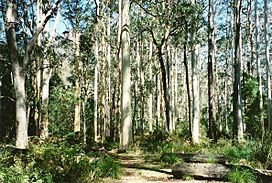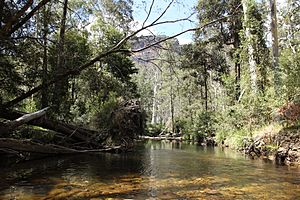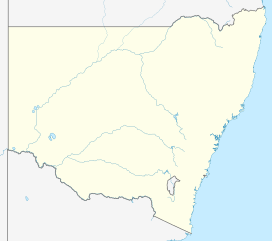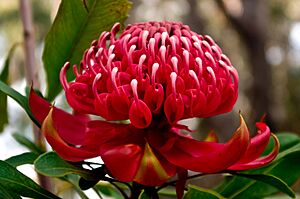Blue Gum Forest facts for kids
Quick facts for kids Blue Gum Forest |
|
|---|---|

Blue gums at the Blue Gum Forest
|
|
| Map | |
| Geography | |
| Location | Australia |
| Coordinates | 33°36.45′S 150°21.48′E / 33.60750°S 150.35800°E |
| Administration | |
| Governing body | NSW National Parks & Wildlife Service |
The Blue Gum Forest is a special forest found in the Blue Mountains National Park. It's located in the Grose Valley part of the Blue Mountains in New South Wales, west of Sydney, Australia. It is one of Australia's most famous places for bushwalking (hiking).
This forest is part of the UNESCO World Heritage Site called the Greater Blue Mountains Area. This means it's a very important natural place that the world protects. The Blue Gum Forest was saved from being destroyed thanks to the hard work of early Australian conservationists (people who protect nature).
Contents
Exploring the Blue Gum Forest

The Blue Gum Forest is mostly filled with super tall Mountain Blue Gum (Eucalyptus deanei) trees. These trees have a layer of smaller shrubs growing beneath them. You can only reach this forest by walking. Several trails from different parts of the Grose Valley lead to the forest.
The quickest way to get there from Blackheath is by taking the Perrys Lookdown track. This path goes down 656 metres (about 2,152 feet) to the forest. Walking back up is considered a "hard" climb, so it's a real challenge!
One amazing tree in the Blue Gum Forest is 65 metres (about 213 feet) tall. Its trunk is 6 metres (about 20 feet) around! This giant tree is over 600 years old and is a famous landmark for hikers. To protect the forest, camping is not allowed directly in the Blue Gum Forest. Instead, you can camp at a nearby spot called Acacia Flat.
Plants of the Forest
While the forest is famous for its Eucalyptus deanei trees, other types of eucalyptus trees also grow here. Smaller trees and shrubs include paperbarks (Melaleuca styphelioides), different kinds of acacias, and the Yellow Pittosporum (Pittosporum revolutum). On the forest floor, you can find grasses, vines, beautiful orchids (Caladenia picta), and ferns.
Animals of the Forest
The Blue Gum Forest is home to many animals. You might spot Common brushtail possums, greater gliders, eastern grey kangaroos, spotted-tail quolls, and rock wallabies. Birds are also very common, both on the ground and flying high in the trees. Look out for colourful parrots like the crimson rosella and the large yellow-tailed black cockatoo.
Forest Fires
Many of the trees in the forest are about 300 years old. They might have grown after a big bush fire. Regular, smaller fires actually help the eucalyptus trees grow and stop other types of rainforest trees from taking over. However, very strong fires can harm the forest. The Grose Valley has had bushfires many times, including in 1982 and November 2006. The Blue Gum Forest was even damaged by controlled burning (back burning) during these fires. After the severe fires in 2006, the forest and its walking tracks were closed for a while to allow the plants to grow back.
History of the Blue Gum Forest
First People of the Mountains
In 1804, an explorer named George Caley climbed nearby Mount Banks. He saw campfires, which showed that Indigenous Australians were living there. The Blue Mountains area was part of the land of the Darug people. There is also proof that the Wiradjuri and Gandangara people from other areas had connections to the Blue Mountains. Tools and signs of ancient camps have been found in the Grose Valley, some very close to the Blue Gum Forest.
Early Tracks and Photos
Around 1858, a group called the Royal Engineers started building a long track, about 70 kilometres (43 miles) long. This track was meant for a new railway line. But they decided to build the railway somewhere else, along the ridge. This old track, known as the Engineers Track, became a useful path for walkers, farmers, and explorers.
In 1859, a photographer named Robert Hunt took some of the very first photos in Australia right here in the forest. Later, in the 1860s, a cattle rustler (someone who steals cattle) named Ben Carver used this track. He even bought a lease for the area in 1875. Today, only a small part of the original Engineers Track still exists.
Artists and Early Protection
In 1875, the Blue Gum Forest became a special spot for artists. Frederick Eccleston Du Faur from the Academy of Art set up an artists' camp there. More than twenty artists, photographers, and academics camped in the forest. This led to many beautiful photographs by Alex Bischoff and drawings and paintings by William Piguenit.
Because of its beauty, the entire Grose Valley and the areas around it were protected. It was called a "national spectacle." At that time, Australia didn't even have national parks yet, and it wasn't even a country! But this protection was like Australia's very first "national park." However, even with this special status, the forest still faced threats later on. A rich family who owned shops, the Horderns, bought a lease in the Blue Gum Forest. They didn't plan to build anything, but people jokingly called this part of the valley "the Hordern Pavilion" after their famous building.
Saving the Forest
The Grose Valley became a very important place for the modern conservation movement in New South Wales. The Blue Gum Forest was saved from being destroyed in 1931–32.
At Easter in 1931, a group from the Sydney Bush Walkers Club was camping in the forest. Their leader was Alan Rigby. They met a farmer from Bilpin named Clarrie Hungerford. Hungerford had a lease on the forest and told the bushwalkers he planned to cut down the blue gum trees to plant walnuts. There were also other dangers to the forest, like plans for a railway line, a dam, a power station, and even mining for coal and shale.
The bushwalkers decided they had to stop him. They started a campaign and managed to collect £130 (Australian pounds). This was a lot of money during the Great Depression, a time when many people had no jobs. They paid Hungerford this money so he would give up his lease. They met him in the Blue Gum Forest on November 15, 1931, during a heavy rain, and he agreed to their idea.
A big part of the money, £80, came as a loan from James Cleary. He was the head of the NSW railways and later led the Australian Broadcasting Commission. Cleary was also a bushwalker himself. One of the main people who worked hard to save the forest was Myles Dunphy. At that time, he was already making plans for the Blue Mountains National Park.




